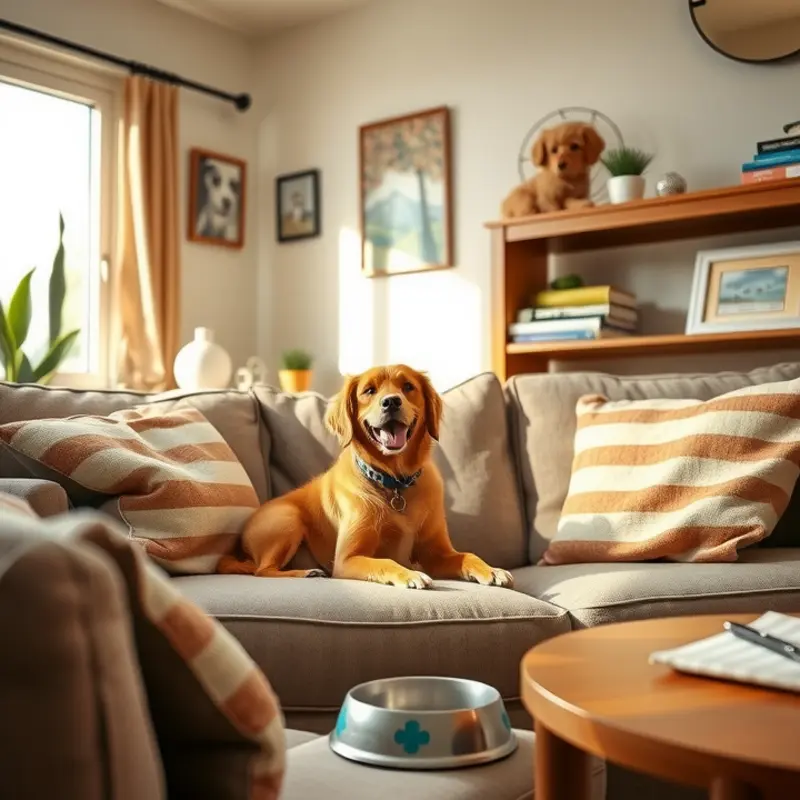Apartment hunting can be a daunting task, and it gets even trickier when you have a pet in tow. As you embark on this adventure, remember that finding a pet-friendly abode isn’t just about square footage and stylish decor; it’s about ensuring your furry buddy feels right at home too. Whether you’re a young professional with a spirited pup, a couple with a cuddly cat, or a family with a couple of wagging tails, this guide will help you navigate the pet-friendly rental landscape. Let’s uncover some strategies, tips, and perhaps a few laughs along the way to make this process as smooth as a Labrador’s fur. So put on your best walking shoes (and don’t forget your leash!), because it’s time to dig into the nitty-gritty of apartment hunting with pets.
Pet-Friendly Criteria: What to Look For

Finding a truly pet-friendly apartment requires more than just scanning for listings marked “pet-friendly.” As any pet owner knows, the needs of our companions are varied and unique. Therefore, defining what a pet-friendly apartment means for you and your pet is critical. Let’s break down the components that should be on your checklist.
Weight and Breed Restrictions
Check for weight and breed restrictions in all rental agreements. Even apartments listed as pet-friendly may have a maximum weight limit for pets, often around 25-35 pounds. Some apartments restrict certain breeds, usually larger ones or those perceived as aggressive. If your pet doesn’t fit the common criteria, keep searching until you find a rental that welcomes their uniqueness.
Amenities for Pets
Consider the available amenities that cater to pets. Look for apartments that provide convenient dog-washing stations, dedicated pet play areas, or dog parks nearby. These features enhance your pet’s quality of life and make your living situation easier. It’s also worth considering the building’s proximity to parks and walking trails. The surrounding neighborhood should offer enough green spaces for your pet to stretch their legs and explore safely.
Pet-friendly Flooring and Design
Pets can be tough on flooring, especially if they enjoy a good run around the home. Look for apartments with pet-friendly flooring like tile or laminate that’s easier to clean and doesn’t scratch easily. Carpeting might be cozy, but it’s not ideal for pets prone to accidents. Also, evaluate the layout: open spaces and fewer stairs often make for a happier pet environment.
Policies on Pet Damages
Understanding the property’s policies on pet damage is vital. Some landlords require additional pet deposits or monthly pet rent to cover potential damages. Ensure these fees are reasonable, and discuss what scenarios might result in loss of deposit. A clear policy will help you prepare financially and avoid unexpected costs if your pet’s behavior occasionally colors outside the lines.
Safety and Security
Safety is paramount. Consider if the apartment community has secure entryways or specific measures ensuring your pet’s safety indoors and outdoors. The placement of balconies and windows should also be evaluated for potential hazards, like falls or escapes. Consider implementing additional safety measures, like pet gating, to enhance security, or apartment balcony safety netting for high-rise units.
Nearby Pet Services
Check the vicinity for essential pet services such as veterinarians, grooming shops, and pet supply stores. Making these services easily accessible will prove invaluable during emergencies, routine care, or whenever you need supplies without traveling far.
Understanding and considering these criteria will better equip you to find an apartment that suits both you and your furry friend. It’s about ensuring you’re not just finding a place to live but a pet-friendly environment that meets all your needs, promoting harmony for you both.
The Art of Negotiation: Lease Terms and Pet Deposits

Negotiating lease terms when you have pets can feel like a delicate dance. Pet-friendly rentals might seem like a dime a dozen, but understanding the terms presented and advocating for your furry friend is crucial. Knowing when and how to negotiate pet deposits can save you money and ensure you remain on good terms with your landlord.
Understand the Lease Terms
Start by thoroughly reviewing the lease for any pet-related clauses. Look for details regarding pet deposits, monthly pet rent, and specific restrictions on breed or size. Some leases may have general language regarding pets, while others stipulate precise terms.
In cases where leases mandate a non-refundable pet fee or monthly charges, don’t hesitate to question the necessity of these fees. Approach the negotiation tactfully, showcasing your proactive approach. Highlight good practices like pet insurance or training certificates, which might reassure landlords of reduced risk.
Arm Yourself with Market Knowledge
Before entering negotiations, equip yourself with information about average pet deposits in the area. Landlords aren’t immune to competitive pressures, and having data about local standards can provide leverage. Demonstrating awareness of the market establishes you as an informed renter who knows their rights and the going rates.
A useful strategy is to inquire about pet-friendly areas in your locality to understand where your best negotiating opportunities might lie. Resources like this guide can help identify areas more open to flexible terms.
Leverage Your Pet’s Track Record
If you can present your pet as low-risk, your negotiation leverage increases. Collect past landlord references and records demonstrating well-behaved pets. Highlight aspects such as being vaccinated, spayed or neutered, house-trained, and without incident in previous rentals.
Offering a ‘pet resume’ detailing your pet’s past behavior and training can also shift the conversation. It showcases dedication to responsible pet ownership, potentially leading to waived or reduced fees.
Discuss Terms Openly, But Politely
Approach lease negotiations with a cordial and open mindset. Express willingness to find a mutually beneficial agreement. Articulate your understanding of landlord concerns and indicate your commitment to maintaining apartment integrity.
Expressing a genuine interest in resolving pet-related concerns can facilitate a landlord’s readiness to be flexible. Suggest compromises that provide them security while granting you some financial relief.
Consider Alternative Arrangements
If you face resistance on pet deposits, propose alternative solutions. Perhaps offering an additional month’s rent in place of a hefty deposit could be an agreeable compromise. This demonstrates your understanding of potential liabilities while reflecting your commitment to accountability.
Ultimately, your goal is to strike a balance that permits you and your pet a harmonious living arrangement. Mastering the art of negotiation with care, knowledge, and empathy ensures success in tackling lease terms that accommodate both you and your beloved pet.
Final words
Finding the perfect apartment for you and your pet doesn’t have to be a bumpy ride. By understanding the ins and outs of pet-friendly rentals and being savvy negotiators, you can secure a home where you both feel welcomed and at ease. Remember, patience is key! With a little effort and perhaps a few treats, you can turn the search for your new cozy haven into an exciting adventure for you and your furry best friend. Your ideal home is out there, just waiting for you to discover it together.









